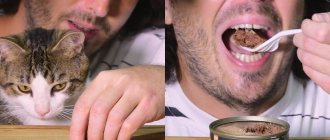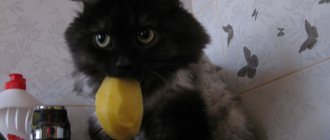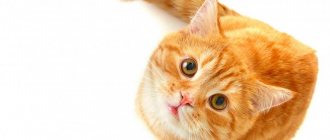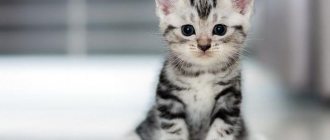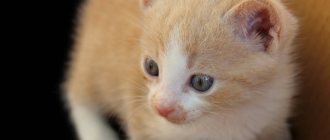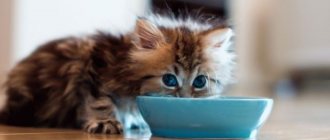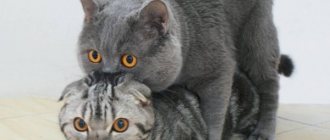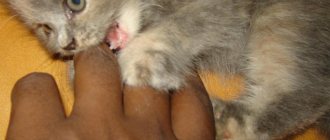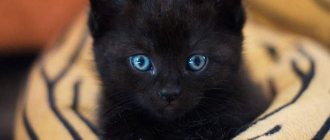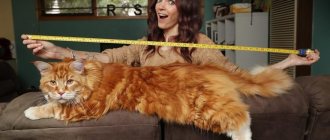Dry food is not only suitable as the first independent food in the life of small pets, but is also the best option. But there is one amendment: the product must be of high quality, balanced and designed specifically for kittens. Why is this so important?
The fact is that babies grow very quickly, they have an accelerated metabolism and for proper development they need nutritious food containing a full range of vitamins and minerals. High-quality feed is developed taking into account the needs of the body during the period of rapid growth and development and daily saturates it with all the substances necessary for this. It is impossible to achieve the same result with natural feeding. That is why, with this type of feeding, pets are also given additional vitamin and mineral supplements. In addition, it is worth considering that kittens have sensitive digestion. Incorrectly selected or insufficiently high-quality products can lead to serious digestive disorders or even poisoning, so you need to be careful in this matter. In addition, do not forget that sudden changes in food cause a blow to the body of even an adult healthy cat, and with fragile babies you need to be much more careful.
Features of feeding a kitten with industrial food
Kittens can drink their mother's milk for up to 2 months or more. But a growing body requires more useful elements and nutrients, which can be additionally obtained from natural products or industrial diets. The latter products are given greater preference, but only if they are of high quality.
Rules for feeding prepared rations:
- Dry granules can be introduced into a kitten’s menu from the age of 3 weeks to 1 month, depending on the characteristics and pace of its development. The optimal time is when the baby's teeth are cutting through and he begins to show interest in solid objects.
- Dry food is healthy and excellent for kittens, but giving it as the only product present in the diet is allowed provided that the owner will continue to feed it to the pet in the future.
- It is correct to introduce your baby to new food - before introducing the kitten to hard granules, they need to be soaked in water or milk.
- Choose a quality product that replenishes the lack of vitamins and minerals for a growing body.
The need for complementary feeding for kittens up to 1 month
The benefit of breast milk lies not only in its fortified composition, but also in the transfer of protective antibodies. Together with him, the baby receives passive immunity, protecting against infections until the first vaccinations.
If natural feeding is not possible, then artificial milk formulas are introduced into the diet. You can buy them at a pet store or veterinary pharmacy.
NOTE!
The use of goat's and cow's milk is only permissible on a short-term basis. Their prolonged use causes intestinal problems and contributes to the development of vitamin deficiency.
How to choose dry food for a kitten
There are many industrial feeds. They differ in their prices, tastes and benefits for a growing body. You should choose food intended directly for kittens. You should not give your baby food designed for an adult animal.
Optimal options.
The highest quality food is in the holistic category. It contains only natural products and is a complete replacement for natural food.
But holistic products have one drawback - their high price. And since it is not recommended to switch the kitten to lower quality food in the future, the owner must immediately decide whether he can support the expensive food for his pet.
Super-premium and premium-class feeds are also of good quality. Giving your pet Budget Economy is not recommended. These foods contain few natural products and many harmful food additives.
Studying the label. When choosing food, you should carefully study its composition:
- Meat should be listed first on the list of ingredients. This is a source of protein necessary for the full development and active growth of a kitten. It is not recommended to choose food that contains offal as a source of protein.
- Wheat – this ingredient should not be present in high-quality food. This cereal is poorly absorbed by the kitten's digestive system. In addition, it is a strong allergen.
- Fats – may be present in food, but only of animal origin.
- Omega 3 and 6 fatty acids . These substances are very useful and important for a growing organism. Omega fatty acids have a positive effect on the immune system and keep the animal's skin and coat healthy and beautiful.
- Prebiotics are very good if they are included in kitten food. Such ingredients help improve digestion and maintain the balance of beneficial intestinal microflora. Prebiotics are especially useful for kittens whose gastrointestinal tract does not yet work smoothly and may have problems digesting food.
- Yucca Schidigera . This component is included in high-quality dry food. Yucca extract helps in the absorption of food, normalization of metabolic processes and reduction of flatulence.
If these components are included, the product will be of high quality and suitable for kittens over 1 month of age.
What is a complete diet?
The kitten grows and develops very quickly - its immunity and digestive system have an increased load. The kitten needs a complete, balanced diet that takes into account the needs of the developing and not yet strengthened body. It must contain proteins, fats, carbohydrates, minerals and vitamins in the right quantity and ratio for healthy growth and development. Super-premium industrial feed has all these qualities.
The best option is special food for kittens. The correct combination of dry and wet food in the daily diet, taking into account the pet’s needs for nutrients and energy. This diet is varied and has significant benefits for your pet’s health:
- wet food provides more than 70% of the required daily fluid intake;
- chewing dry food granules maintains dental hygiene due to the effect of a toothbrush;
- dry food can remain in the bowl all day and allows the kitten to eat small meals throughout the day, following its natural instinct.
You should not put dry and wet food in the same bowl. There should be one of the options at one feeding. It is desirable that the food be of the same brand and line, selected according to the age characteristics of the animal and the needs of its body.
How to give dry food to a kitten
Dry granules cannot be given to a one-month-old baby in its pure form. The fact is that the kitten’s teeth are not yet strong enough to gnaw on them, and difficulties may arise with the digestion of such food. To accustom your pet to commercial food at such a young age, it should be properly prepared:
- The granules will need to be filled with low-lactose milk. If you are unable to purchase this product, you can use low- or medium-fat kefir, lean meat broth, or boiled water to dilute the food. Liquids should be at room temperature.
- Cover the container with filled granules with a lid. It is necessary to insist until the granules become soft.
- Crush the softened granules with a fork until smooth.
- If the kitten does not show much attention to new food, you can add a little meat to the crushed food, for example, boiled chicken, but without the skin.
- As the kitten begins to get used to the new food, the amount of liquid for stirring the granules should be reduced.
- During the period of accustoming the kitten to dry food, you should not give it other food. The pet must remember that there is only one food - pellets. This method will help the kitten get used to commercial food faster.
Unmixed dry food should not be given immediately. The kitten will not be able to chew it completely, and hard pieces with sharp corners can injure the kitten’s esophagus.
Feed classes
We have already mentioned that the answer to the question “should I feed a kitten dry food” very much depends on whether the food is of high quality or not. But how to distinguish them from each other, where is the border? In fact, it is quite simple - you just need to look at the composition. Feeds differ from each other mainly according to four criteria:
— percentage of meat content (the more, the better); — the presence or absence of cereals (preferably the absence, or at least that the composition contains as little wheat and corn as possible); — the presence or absence of artificial additives, flavor enhancers, flavorings; — presence of a vitamin-mineral complex.
Based on this, experts usually distinguish five classes of feed.
1. Economy class
To describe it briefly, these foods do much more harm than good. They are made not from meat, but from meat industry waste (tails, ears, bone meal, etc.), generously flavored with various dyes and flavor enhancers, which are usually harmful to cats. From such food the pet will not receive the proper amount of energy or nutrients. There is no need to talk about vitamins in such foods. This class includes the most “promoted” brands, known from numerous commercials. Another distinctive feature is that they can be bought not in a pet store, but in a regular supermarket. Under no circumstances should you feed your cat such dry food!
Read more about the dangers of such food: Economy class cat food
2. Medium class
The composition is a little better, there are slightly fewer harmful additives, but in general these foods differ little from the previous ones (it is no coincidence that the medium class as such is not always distinguished; these foods are often classified as economy class). Actually, they will contain at best 5-10% meat, the rest will be low-quality by-products, bone meal, and grains. Such foods may already contain a certain amount of vitamins. They can also often be found in supermarkets, but they cost a little more than economy class.
3. Premium class
This food will no longer contain any overtly harmful components, but the meat content (no more than 35%) does not meet the cat’s needs. In general, such food can already be recommended, but only if it is not possible to buy better ones. However, in this case, we still advise you to buy food of the following classes (about them below) in large quantities in online stores or from wholesalers (this will be cheaper) or keep an eye on promotions and discounts in pet stores. Taking this into account, super premium food may not be more expensive than premium food, although they will differ very significantly in quality. This class includes: Monge, Eukanuba, Hills, Royal Canin, Bozita, Night Hunter.
More information about purchasing food: Where to buy cat food?
4. Super premium class
Containing only natural ingredients, this food is balanced in proteins, fats and carbohydrates, and contains a vitamin and mineral supplement. Dry food of this class will almost certainly contain grains, but in most cases not wheat and corn, but rice and potatoes (and they can no longer be called unambiguously harmful). In general, they will fully satisfy the cat’s need for proper nutrition, containing approximately 40-60% meat and high-quality offal (heart, liver, kidneys - which are even useful for cats in a certain amount). An example would be brands such as Leonardo, Sanabelle, Brit Care, Savarra, Pronature Original. You will only find such food in pet stores (or on pet supply websites on the Internet).
5. Holistics
What can I say, holistic food is as close as possible to the nutrition of cats in their natural environment. In this food you will not find any flavor enhancers, artificial preservatives, or even grains. But there is 60% or more meat, and this is mostly fresh and dehydrated meat. Absolutely natural composition. Very good vitamin and mineral supplement. To summarize, we can say that holistic is the best dry food for a cat, it’s definitely worth feeding! Examples of holisticists: Orijen, Acana, Applaws, Carnilove, Grandorf, Pronature Holistic. Therefore, we recommend super premium and holistic foods. This is the kind of nutrition the cats receive at the Murkosha shelter, which allows them to be healthy, vigorous and active.
When can a kitten eat dry food in its pure form?
You can give unsoftened granules no earlier than the pet turns 3 months old and only on the condition that by that time he is already eating commercial finished products. Rules and recommendations for feeding a kitten with dry food in its pure form:
- It is recommended to choose food from one manufacturer and in the future buy only that for your pet. You should not change brands, as this may negatively affect the kitten’s health.
- Give only the serving size indicated by the manufacturer on the packaging. At such a young age, the kitten cannot yet control its satiety. He has a way of eating everything that is poured into his bowl. This is fraught with problems with the digestive system and obesity in adulthood.
- Be sure to follow the drinking regime. Dry granules contain no moisture at all, and the water requirement of a growing organism is high. Therefore, the kitten’s bowl should always be filled with clean, fresh water. It needs to be changed at least 2 times a day.
Mixed type. If it is not recommended for adult cats to mix industrial food and natural products, then the situation with kittens is somewhat different.
Veterinarians recommend, in addition to dry food, to give kittens calcined cottage cheese, kefir of minimal or medium fat content, lean meat and boiled chicken fillet without skin.
But combining dry granules and natural food in one bowl is strictly prohibited. These foods should be divided into several meals.
When to start complementary feeding and what should it contain?
In its natural environment, a kitten consumes only its mother's milk until approximately 3 weeks of age. During this period, his body is not yet ready to digest solid food. The transition to “adult” food should occur gradually, over several weeks, in small portions.
A kitten grows very quickly: on average, starting from the third week of life, it gains about 100 g of weight every week. It is important to provide the animal’s body with all the necessary resources during the period of intensive growth. For complementary feeding, both wet food (canned food) at room temperature and dry croquettes soaked in water are used. The main thing is that the food is high in calories, with a balanced mineral composition and a protein content of 35%. Also, the kitten's food should be rich in omega-3 fatty acids for vision development. Excellent options that meet all the above requirements are wet food for kittens PRO PLAN Junior NUTRISAVOUR and dry food PROPLAN Original for kittens. The food contains all the necessary vitamins and minerals that ensure adequate feeding of babies, their healthy growth and development. The OPTISTART® complex includes elements important for a growing body: minerals and vitamins that contribute to normal digestion, support of immune defense, development of the nervous system and musculoskeletal system, as well as sources with a high content of protein, fats and carbohydrates.
Don’t forget that the portion of food should be new each time so that it does not get weathered or spoiled. The dishes must be clean, otherwise there is a risk of proliferation of pathogenic microorganisms. A bowl of fresh water is available - the cat needs to receive approximately 60 ml of water per 1 kg of weight per day.
By the age of 2 months, the kitten can already do without mother’s milk and completely switches to independent feeding. The daily food intake is indicated on the food packaging. It is calculated according to the age and weight of the animal.
The right diet
A cat is a carnivorous animal, and the lion's share of its menu should be meat. Therefore, when feeding a kitten with dry food, it is important to choose a high-quality product with a high content of meat components. They should occupy the first places in the composition list, preferably with an accurate indication of the source. For example, the ingredient “dehydrated turkey meat” inspires much more confidence than “poultry meal.”
You should not focus on the total protein content: some manufacturers include a large number of sources of vegetable protein, which is not at all suitable for the cat’s body.
It is equally important to take into account the age category of the pet when choosing a diet. Special food for kittens differs from “adult” food in two main characteristics:
- Total calories, protein and fat content. The energy costs of a kitten are higher compared to an adult cat. Kids are active and restless, and most importantly, they are constantly growing. When a kitten eats adult cat food, it does not receive the required amount of nutrients.
- Granule size. Relatively large granules designed for adult cats may not be suitable for a small kitten. They are difficult to chew, they do not fit in the mouth, which ultimately discourages the pet from interested in dry food.
Access to water
While wet food already contains a significant amount of liquid, dry food has virtually none. Therefore, it is extremely important to ensure that your kitten gets enough water intake. Otherwise, he may face kidney and bladder diseases in the future.
The water must be fresh and clean, drinking quality - the same as that used for all family members. It should be poured into a bowl that is comfortable for the kitten. Glass, porcelain and stainless steel are preferable to plastic: cats are sometimes put off by the strong smell of plastic.
The place where you leave the container with the drink is also important: ideally, it should be at least 50 cm away from the food bowl and tray. If you have a spacious home, place bowls of water in two or more rooms - this way your baby, busy playing and learning about the world around him, will be more likely to remember water.
When the kitten drinks, saliva and food debris get into the bowl. The water quickly becomes cloudy and loses its attractiveness in the eyes of the animal, so do not be lazy to change it more often. You should not allow an older cat to drink from the toilet: there may be pathogens and detergent residues there.
